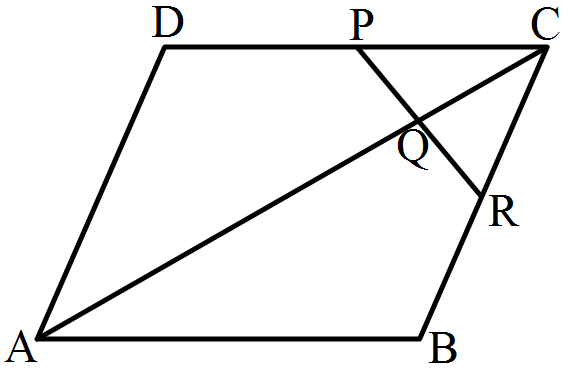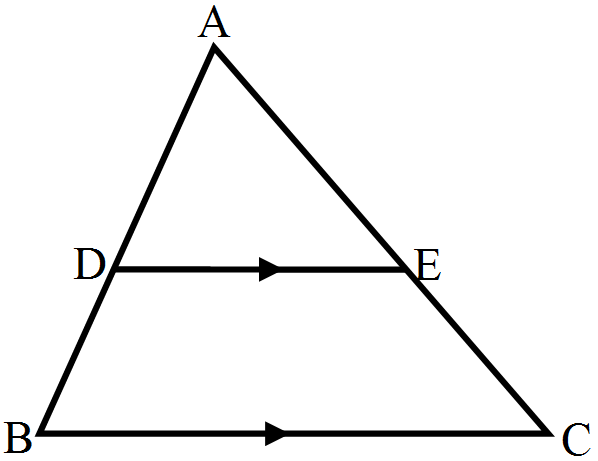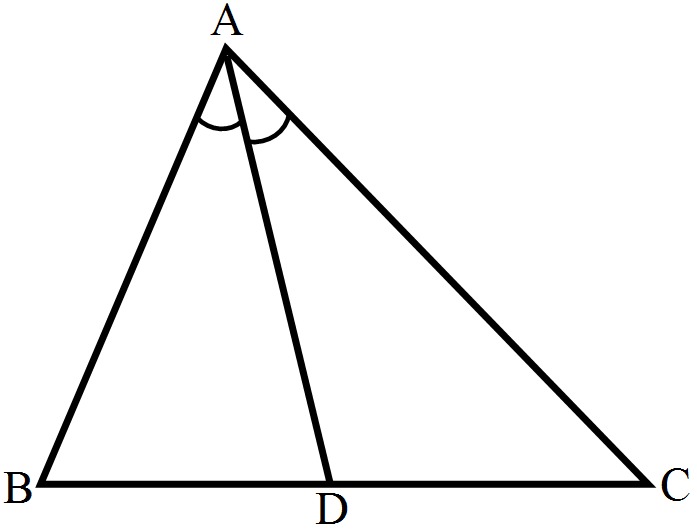ABCD is a parallelogram in which P is the midpoint of DC and Q is a point on AC such that $\text{CQ}=\frac{1}{4}\text{AC}.$ If PQ produced meets BC at R, prove that R is the midpoint of BC.


We know that the diagonals of a parallelogram bisect each other.
Therefore,
$\text{CS}=\frac{1}{2}\text{AC}\dots(\text{i})$
Also, it is given that $\text{CQ}=\frac{1}{4}\text{AC}\dots(\text{ii})$
Dividing equation (ii) by (i), we get:
$\frac{\text{CQ}}{\text{CS}}=\frac{\frac{1}{4}\text{AC}}{\frac{1}{2}\text{AC}}$
or, $\text{CQ}=\frac{1}{2}\text{CS}$
Hence, Q is the midpoint of CS.
Therefore, according to midpoint theorem in $\triangle\text{CSD}$
PQ || DS
If PQ || DS, we can say that QR || SB
In $\triangle\text{CSB},\text{Q}$ is midpoint of CS and QR || SB.
Applying converse of midpoint theorem, we conclude that R the midpoint of CB.
This comletes the proof .
Therefore,
$\text{CS}=\frac{1}{2}\text{AC}\dots(\text{i})$
Also, it is given that $\text{CQ}=\frac{1}{4}\text{AC}\dots(\text{ii})$
Dividing equation (ii) by (i), we get:
$\frac{\text{CQ}}{\text{CS}}=\frac{\frac{1}{4}\text{AC}}{\frac{1}{2}\text{AC}}$
or, $\text{CQ}=\frac{1}{2}\text{CS}$
Hence, Q is the midpoint of CS.
Therefore, according to midpoint theorem in $\triangle\text{CSD}$
PQ || DS
If PQ || DS, we can say that QR || SB
In $\triangle\text{CSB},\text{Q}$ is midpoint of CS and QR || SB.
Applying converse of midpoint theorem, we conclude that R the midpoint of CB.
This comletes the proof .
Download our appand get started for free
Experience the future of education. Simply download our apps or reach out to us for more information. Let's shape the future of learning together!No signup needed.*
Similar Questions
- 1View SolutionThe sides of certain triangles are given below. Determine them are right triangles:
1.6cm, 3.8cm, 4cm. - 2View SolutionFind the height of an equilateral triangle of side 12cm.
- 3D and E are points on the sides AB and AC respectively of a $\triangle\text{ABC}$ such that DE || BC:View Solution
If AD = 3.6cm, AB = 10cm and AE = 4.5cm, find EC and AC.

- 4A man goes $10\ m$ due south and then $24\ m$ due west. How far is he from the starting point?View Solution
- 5$\triangle\text{ABC}\sim\triangle\text{DEF}$ such that $\text{ar}(\triangle\text{ABC})=64\text{cm}^2$ and $\text{ar}(\triangle\text{DEF})=169\text{cm}^2.$ If BC = 4cm, find EF.View Solution
- 6View SolutionState Pythagoras theoram.
- 7View SolutionFind the lenght of each side of a rhombus whose diagonals are 24cm and 10cm. long.
- 8In a $\triangle\text{ABC},\text{AD}$ is the bisector of $\angle\text{A}.$View Solution
If AB = 5.6cm, AC = 4cm and DC = 3cm, find BC.

- 9An aeroplane leaves an airport and flies due north at a speed of $1000\ km$ per hour. At the same time, aeroplane leaves the same airport and flies due west at a speed of $1200\ km$ per hour. How far apart will be the two planes after $1\frac{1}{2}\text{hour}?$View Solution
- 10In $\triangle\text{ABC},\text{D}$ is the midpoint of $BC$ and $\text{AE}\perp\text{BC}.$ If $\text{AC}>\text{AB},$ show that.View Solution
$\text{AB}^2=\text{AD}^2-\text{BC}.\text{DE}+\frac{1}{4}\text{BC}^2.$
